Samsung has successfully established itself as an innovator in flash-based storage across the enterprise and consumer markets. For example, the prosumer-oriented Samsung 960 Pro M.2 NVMe SSD recently broke our consumer SSD benchmark record for sequential performance while also reaching the highest capacity of any M.2 drive on the market. Two and a half years ago, Samsung was first to market with an enterprise NVMe SSD with its XS1715, which maintained a dominant position among enterprise NVMe SSDs though 2015. Thus, we were excited to begin our benchmark of Samsung’s successor to the XS1715 — the PM1725 NVMe PCIe SSD.
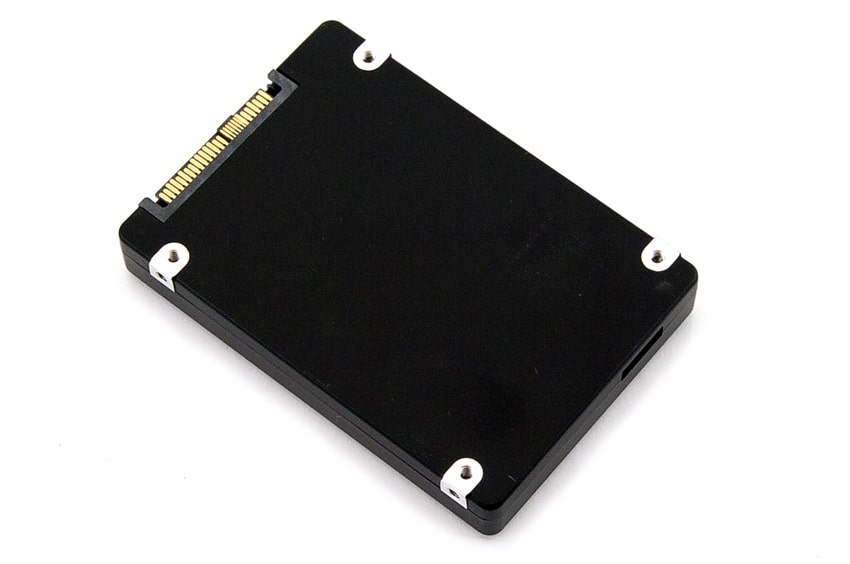
Back in 2013 when Samsung announced the XS1715, they made waves as the first vendor to offer an NVMe SSD for enterprise applications. When the XS1715 entered general availability in 2014, its performance delivered on the promise of the new form factor. Major server vendors like Dell and HPE were quick to provide recommended configurations for the new XS1715. This was part of the reason that the drive had such staying power–even as other enterprise SSD vendors began to roll out their own NVMe storage.
Thus far, the rollout of the PM1725 has been more understated than its famous predecessor. In terms of on online presence, Samsung provides a datasheet and a bit of other information oriented towards use cases where the PM1725 is deployed as an add-on card. Going into the review, we knew that the PM1725 uses Samsung’s vertical-NAND (V-NAND) flash technology and that the drive is rated for 5 drive writes per day over a period of 5 years. Samsung has not published the full results of its in-house benchmarks, but the company does report that the PM1725 had better random read performance than its rivals from other vendors.
This review offers an in-depth look at how the PM1725 compares to its predecessor (the XS1715), as well as NVMe SSD offerings from other vendors. We had the opportunity to profile the performance of a 2.5-inch version of the drive in its 3.2TB model, the largest capacity available in that form factor. The HHHL form factor is available in sizes up to 6.4TB.
Samsung PM1725 NVMe SSD Specifications
- Form Factor: 2.5-inch
- Capacity options: 800GB, 1.6TB, 3.2TB
- Host Interface: PCIe Gen3 x4
- Sequential Read: Up to 3,100 MB/s
- Sequential Write: Up to 2,000 MB/s
- Random Read: Up to 750,000 IOPS
- Random Write: Up to 120,000 IOPS
- MTBF: 2,000,000 hours
- Power Consumption (Active/Idle): 25W/7W
- Endurance: 5 DWPD
- UBER: 1 in 10^17
- Physical Dimensions: 69 x 100 x 14 mm
- Weight: 140 grams
- Form Factor: HHHL
- Capacity options: 3.2TB, 6.4TB
- Host Interface: PCIe Gen3 x8
- Sequential Read: Up to 6,000 MB/s
- Sequential Write: Up to 2,000 MB/s
- Random Read: Up to 1,000,000 IOPS
- Random Write: Up to 120,000 IOPS
- MTBF: 2,000,000 hours
- Power Consumption (Active/Idle): 25W/7W
- Endurance: 5 DWPD
- UBER: 1 in 10^17
- Physical Dimensions: 69 x 100 x 14 mm
- Weight: 210 grams
Build and Design
Our Samsung PM1725 review unit uses a 2.5-inch NVMe form factor with an SFF-8639 connector.
The PM1725 incorporates tantalum capacitors as part of its power-loss protection system. In the event of power loss, the capacitors provide enough energy to write to flash any data that is currently cached in DRAM.
Testing Background and Comparables
The StorageReview Enterprise Test Lab provides a flexible architecture for conducting benchmarks of enterprise storage devices in an environment comparable to what administrators encounter in real deployments. The Enterprise Test Lab incorporates a variety of servers, networking, power conditioning, and other network infrastructure that allows our staff to establish real-world conditions to accurately gauge performance during our reviews.
We incorporate these details about the lab environment and protocols into reviews so that IT professionals and those responsible for storage acquisition can understand the conditions under which we have achieved the following results. None of our reviews are paid for or overseen by the manufacturer of equipment we are testing. Additional details about the StorageReview Enterprise Test Lab and an overview of its networking capabilities are available on those respective pages.
Comparable drives for this review:
Application Workload Analysis
In order to understand the performance characteristics of enterprise storage devices, it is essential to model the infrastructure and the application workloads found in live production environments. Our first benchmarks for the Samsung PM1725 are therefore the MySQL OLTP performance via SysBench and Microsoft SQL Server OLTP performance with a simulated TCP-C workload. For our application workloads, each drive will be running 2-4 identically configured VMs.
StorageReview’s Microsoft SQL Server OLTP testing protocol employs the current draft of the Transaction Processing Performance Council’s Benchmark C (TPC-C), an online transaction processing benchmark that simulates the activities found in complex application environments. The TPC-C benchmark comes closer than synthetic-performance benchmarks to gauging the performance strengths and bottlenecks of storage infrastructure in database environments. Each instance of our SQL Server VM for this review uses a 333GB (1,500 scale) SQL Server database and measures the transactional performance and latency under a load of 15,000 virtual users.
It is common for storage in this performance class to saturate the available bandwidth during the SQL Server performance benchmark and therefore, high-speed storage devices often achieve similar performance. The Samsung PM1725 did perform similarly to the comparables, but clocked in with the lowest performance among its peers, even scoring slightly lower than the XS1715.
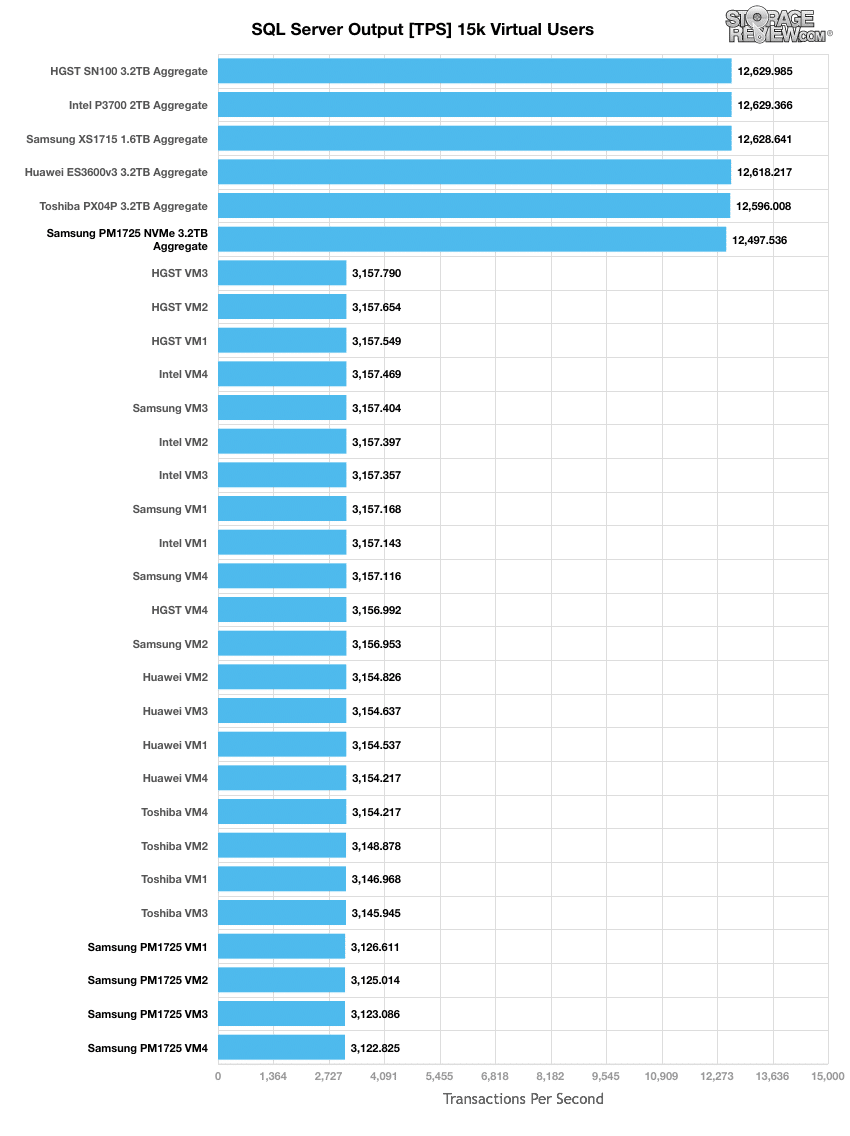
The PM1725 experienced the worst average SQL Server latencies among the comparables, at an average of 57.8ms–more than eight times the average latency of the front-running HGST SN100.
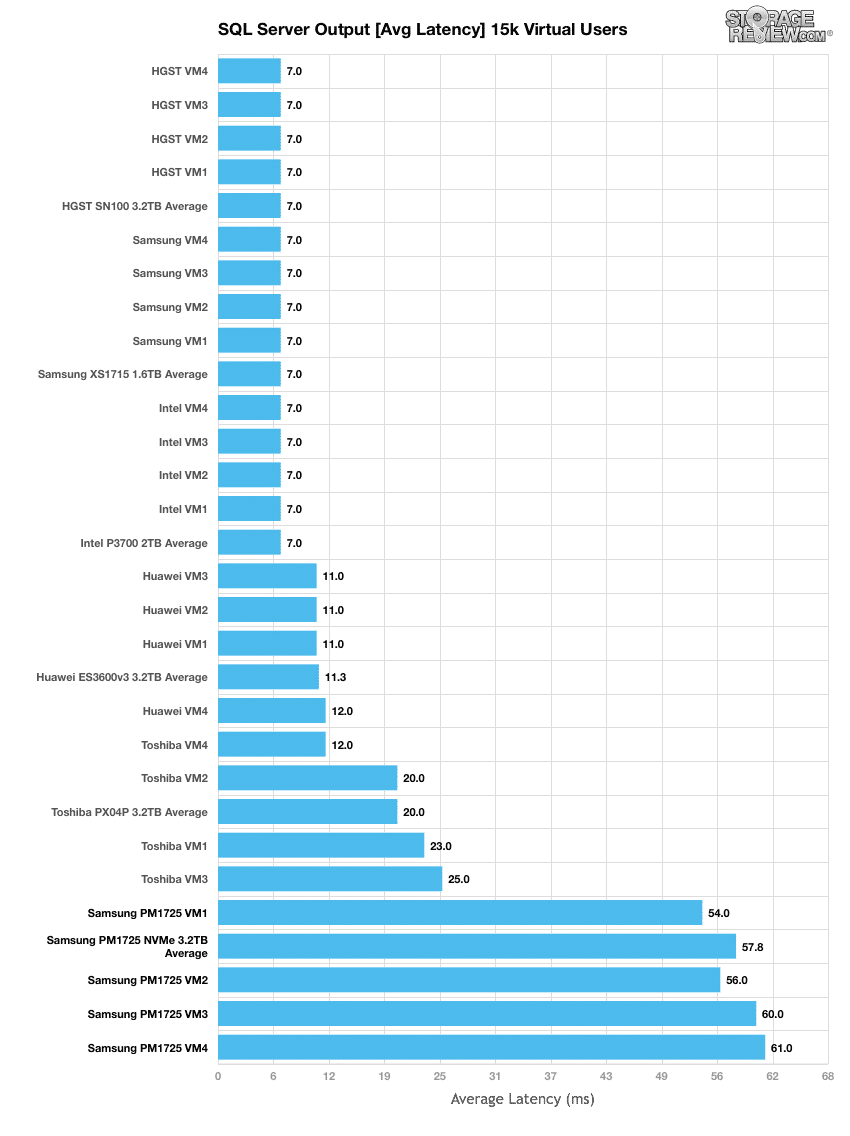
The next application benchmark consists of a Percona MySQL OLTP database measured via SysBench. This test measures average TPS (Transactions Per Second), average latency, as well as average 99th percentile latency. Percona and MariaDB are using the Fusion-io flash-aware application APIs in the most recent releases of their databases; however, for the purposes of this comparison we test each device in their “legacy” block-storage modes.
The Samsung PM1725 also struggled during the Percona MySQL benchmark protocol with an aggregate TPS score of 4,385, only beating out the Samsung XS1715 from among the comparables.
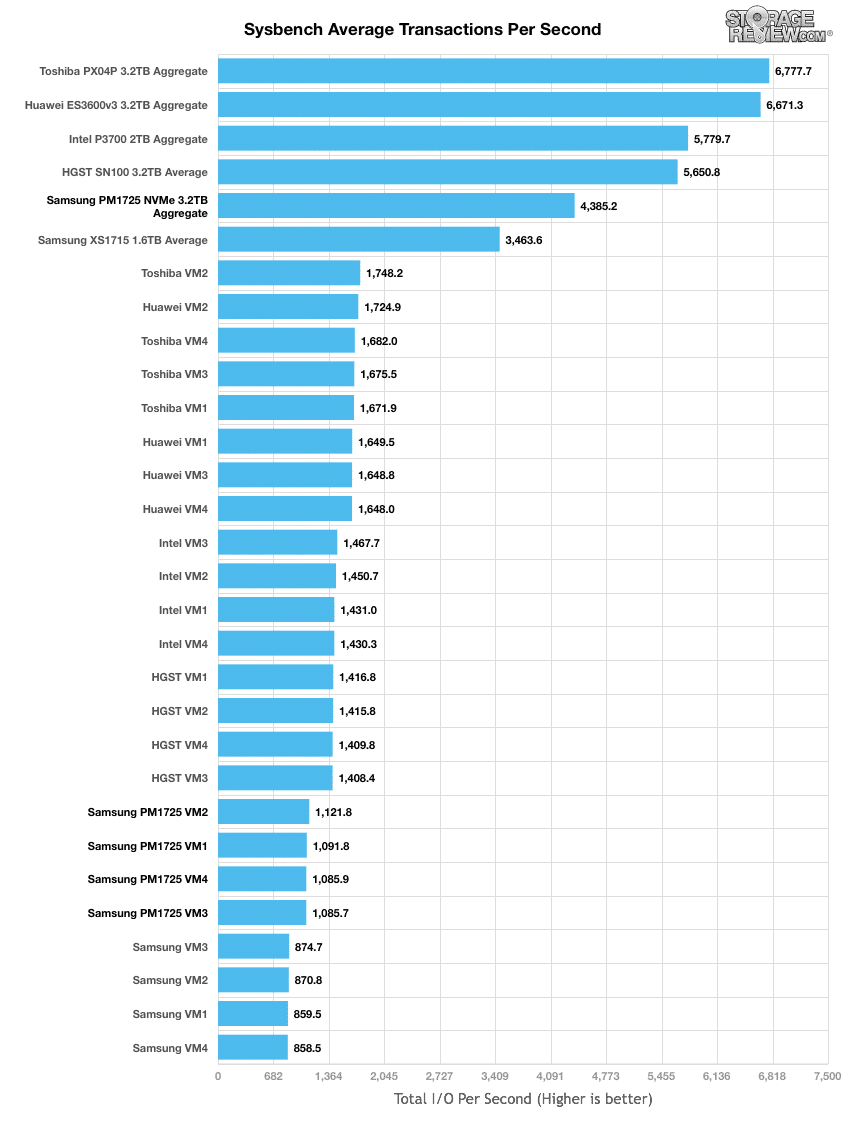
The PM1725’s average latency results during the MySQL benchmark echo its throughput performance. At 28.52ms, the PM1725 was only faster than its predecessor the Samsung XS1715.
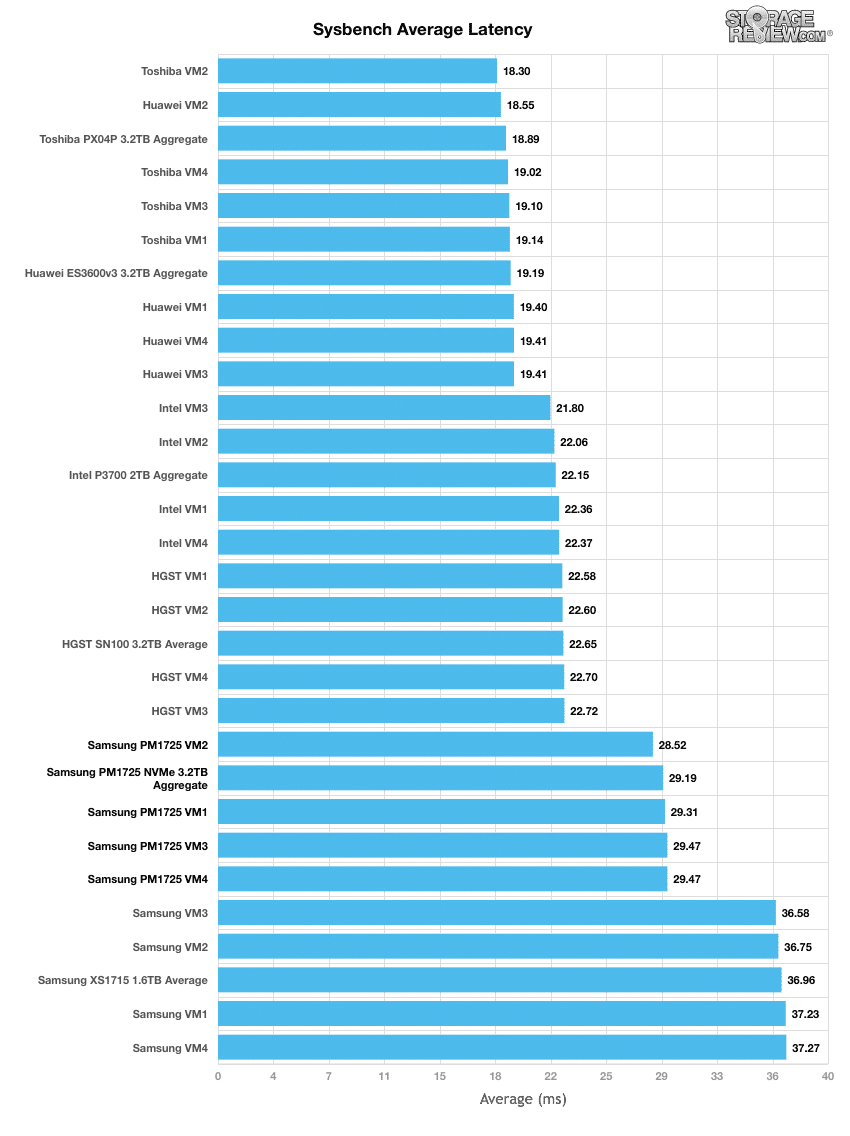
By plotting the worst-case MySQL latency results from Sysbench, we see that the PM1725 does edge out the Memblaze PBlaze 4. However, its results in this regard were unremarkable compared to more recent NVMe SSD comparables.
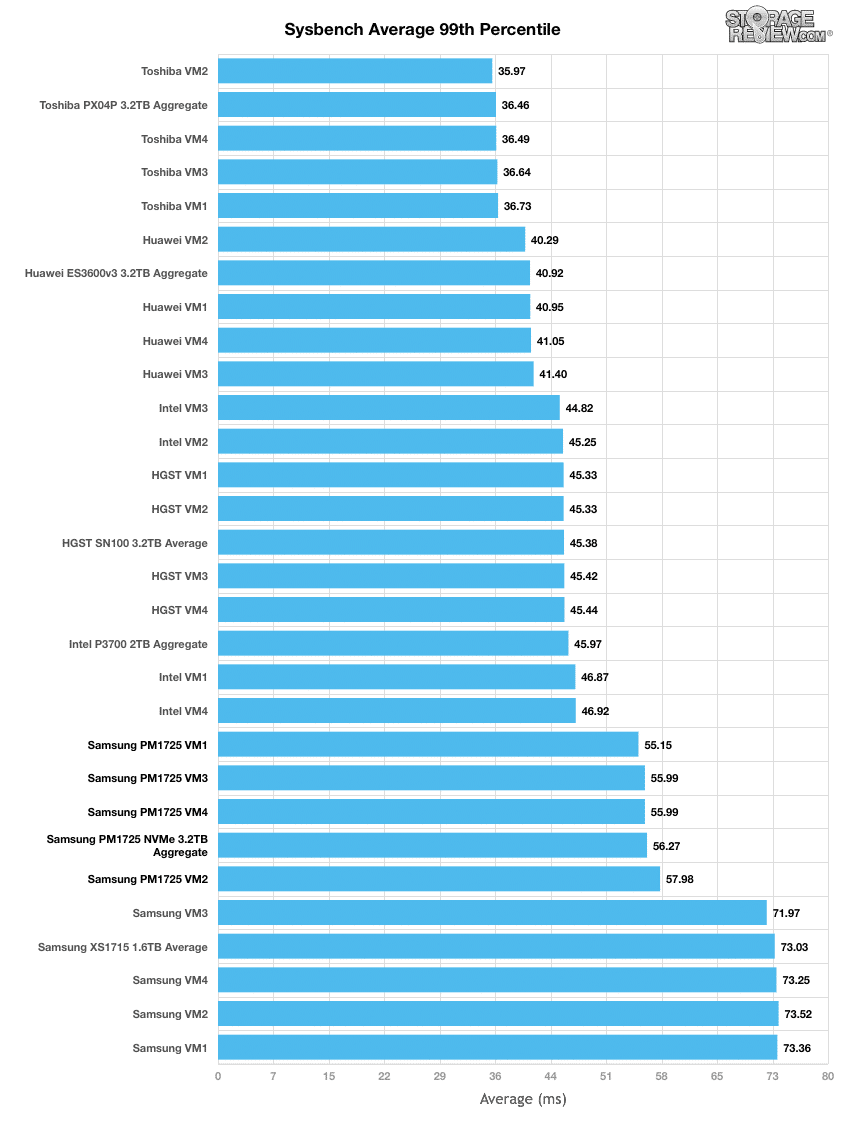
Enterprise Synthetic Workload Analysis
Flash performance varies as the drive becomes conditioned to its workload, meaning that flash storage must be preconditioned before each of the fio synthetic benchmarks in order to ensure that the benchmarks are accurate. Each of the comparable drives is preconditioned into steady-state with a heavy load of 16 threads and an outstanding queue of 16 per thread.
Preconditioning and Primary Steady-State Tests:
- Throughput (Read+Write IOPS Aggregate)
- Average Latency (Read+Write Latency Averaged Together)
- Max Latency (Peak Read or Write Latency)
- Latency Standard Deviation (Read+Write Standard Deviation Averaged Together)
Once preconditioning is complete, each device is then tested in intervals across multiple thread/queue depth profiles to show performance under light and heavy usage. Our synthetic workload analysis for the Samsung 1725PM uses two profiles which are widely used in manufacturer specifications and benchmarks. It is important to take into consideration that synthetic workloads will never 100% represent the activity seen in production workloads, and in some ways inaccurately portray a drive in scenarios that wouldn’t occur in the real world.
- 4K
- 100% Read and 100% Write
- 8K
- 70% Read/30% Write
The Samsung PM1725 experienced its peak “burst” period of 4K write performance after the ten-minute mark during 4K preconditioning. During this window of increased performance, the PM1725 maintained a third-place write performance before settling into second-to-last, just above the throughput of the XS1715.
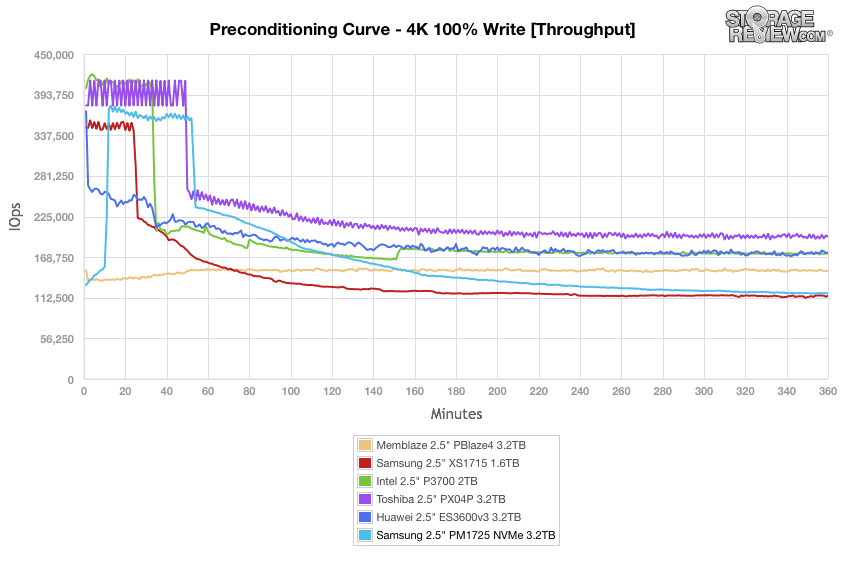
The PM1725’s preconditioning burst period is also reflected in our chart of its average latency for the 4K 100% write workload. After the burst period was over, the PM1725’s latency eventually increased to approximately 2.15ms, faster only than the Samsung XS1715.
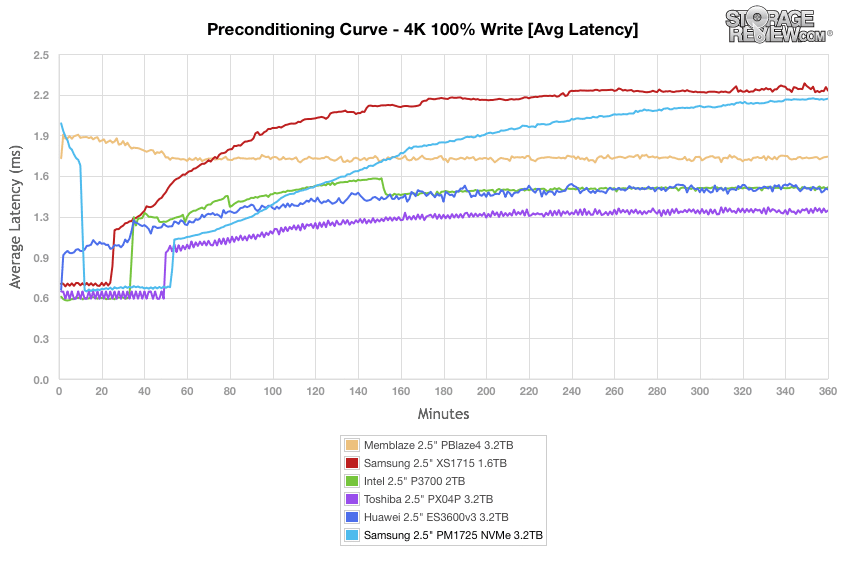
Early in 4K preconditioning, the PM1725’s latency spiked first to 56.8ms and then to 817.2ms, a far outlier among the comparables. After those hiccups, the PM1725 did keep its maximum latency values among the best we measured.
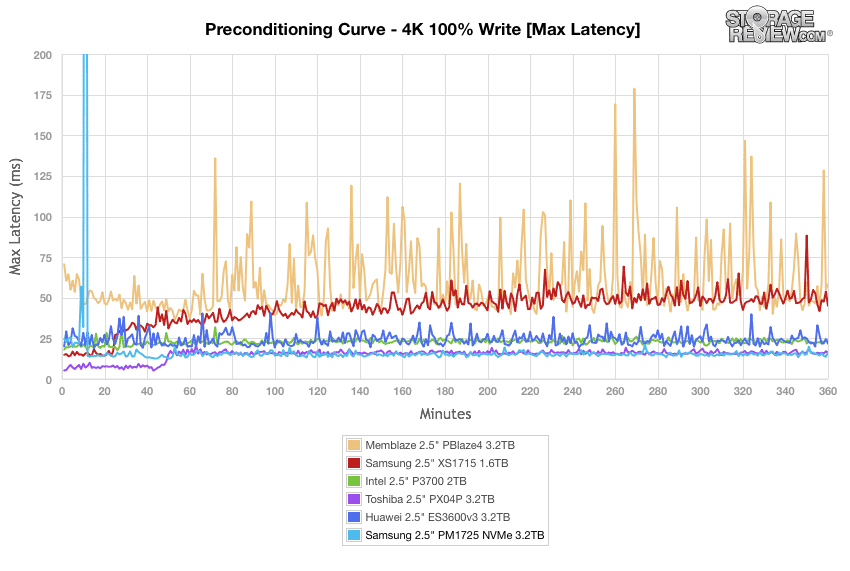
The plotted standard deviation results for 4K preconditioning also highlight the latency issue early on before showing that the PM1725 has write latency results that are fairly consistent. They are, however, not impressive when compared against other recent enterprise NVMe SSDs.
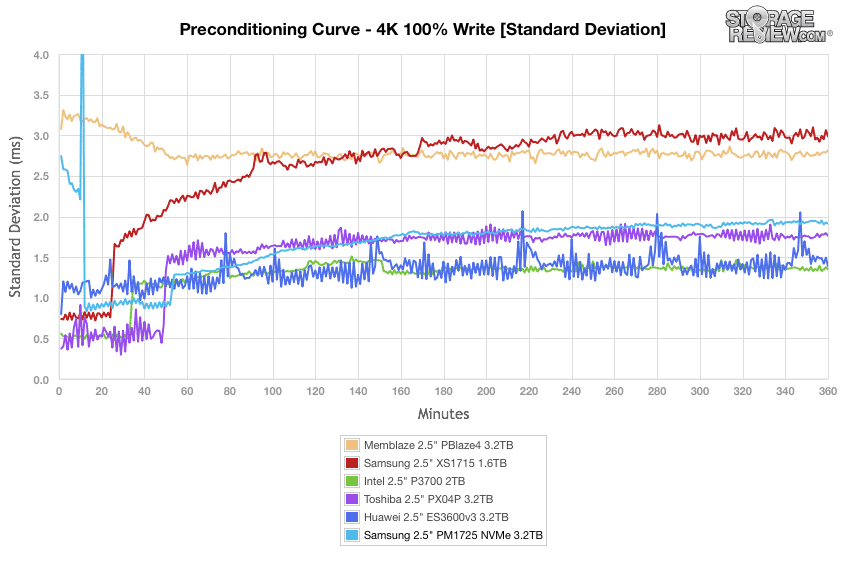
After preconditioning, we measured each of the comparable drives with a sustained 4K 100% read and write workload. The Samsung PM1725 distinguished itself in terms of read performance, beating out the Huawei ES2600 v3 for the best 4K read performance we have measured for a drive in this class. The PM1725’s write throughput of 116,289IOPS came in second-to-last, ahead of the XS1715.
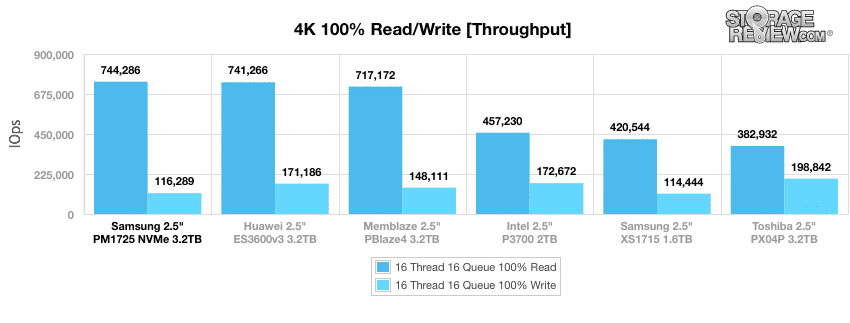
In terms of average latency for 4K read operations, the Samsung PM1725 edged out the Huawei ES3600 v3 to achieve the best result among the comparables. However, write latency clocked in at the second highest, ahead of the XS1715.
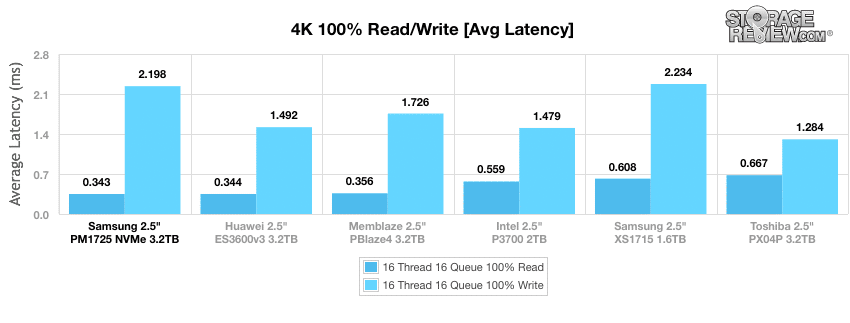
In terms of maximum 4K latency, the PM1725 performed very well against its peers. It scored the second-lowest maximum read latency at 2.3ms and the lowest maximum write latency among the comparables at 17.0ms.
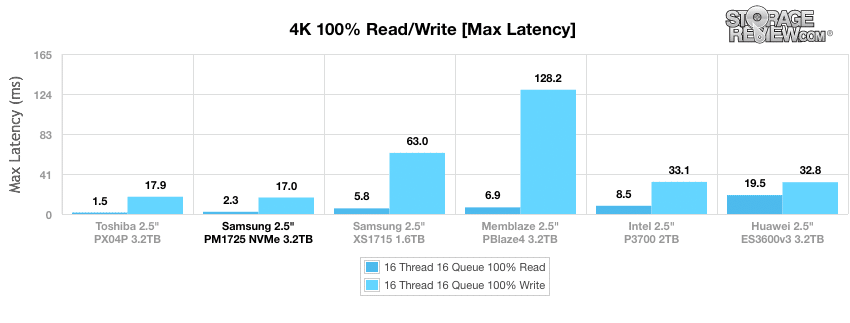
The standard deviation calculation for the PM1725’s 4K read latencies again placed the drive near the Toshiba PX04P at the head of the pack with 0.073ms.
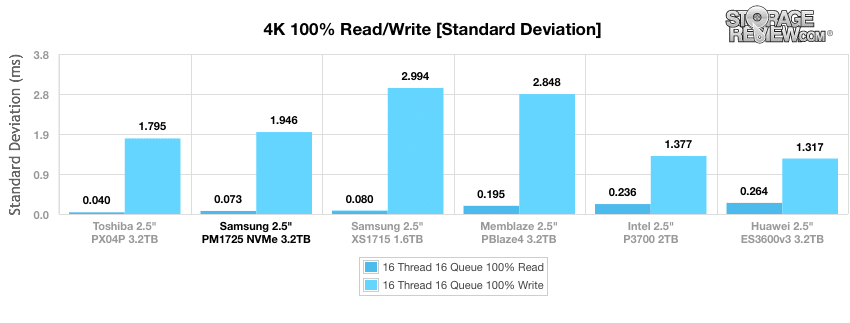
Our next workload uses 8K transfers with a ratio of 70% read operations and 30% write operations. As with the 4K synthetic benchmarks, we start with preconditioning results before switching to the main benchmark. The Samsung PM1725’s period of burst performance was evident during 8K 70/30 preconditioning, when the PM1725 crested well above the other comparables to 315,518IOPS. By the end of preconditioning, the PM1725 settled into a dead heat with the Intel P3700 for second-lowest throughput.
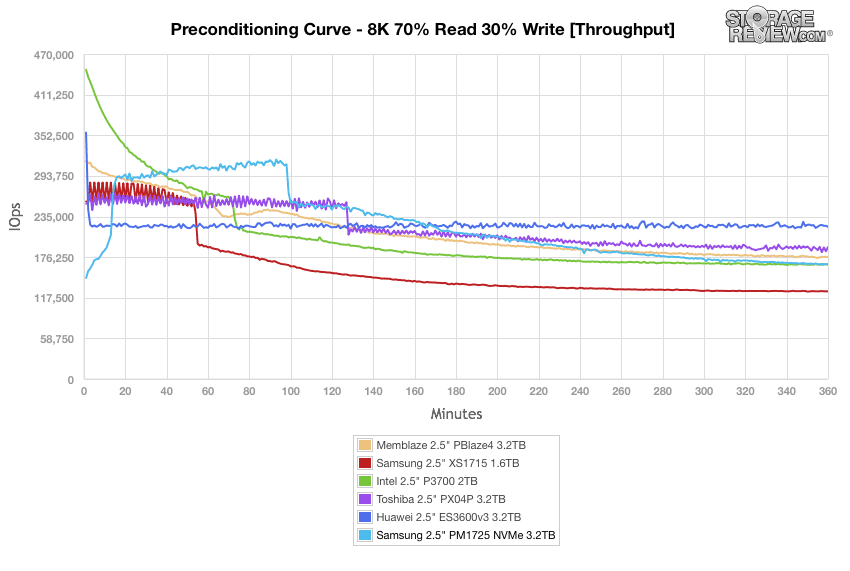
At the beginning of preconditioning, the PM1725 clocked the highest average latency among the comparables. This situation reversed itself after the first few minutes under workload, and the PM1725 eventually beat out all of the other comparable drives during its period of best performance. Farther into preconditioning, the PM1725 again slipped back into a close tie with the Intel P3700 for second-highest average latency.
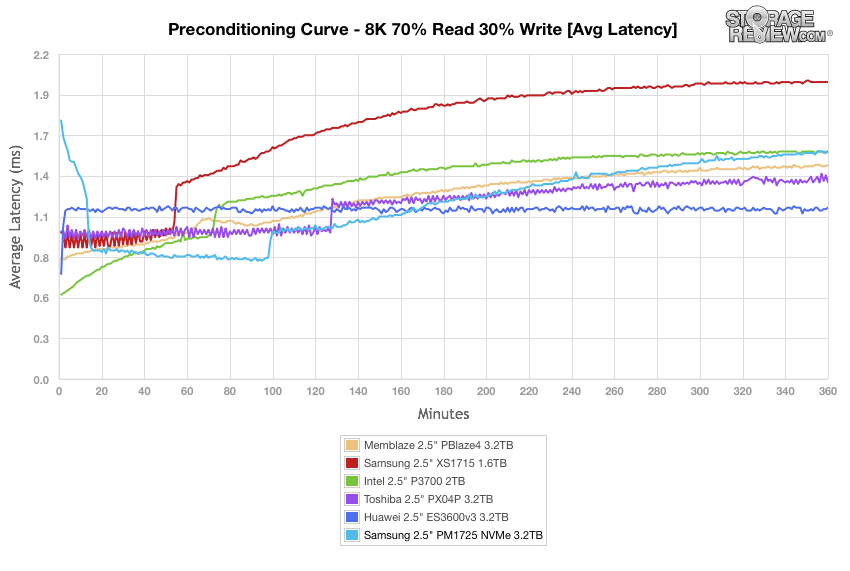
The Samsung PM1725 experienced the most dramatic spikes in latency among any of the comparables during 8K 30/70 preconditioning, although these spikes did occur during the period when the PM1725 was outperforming its peers in terms of throughput. After the three-hour mark, the PM1725 controller was better able to manage maximum latency, reflected by fewer peaks and lower values when peaks did occur.
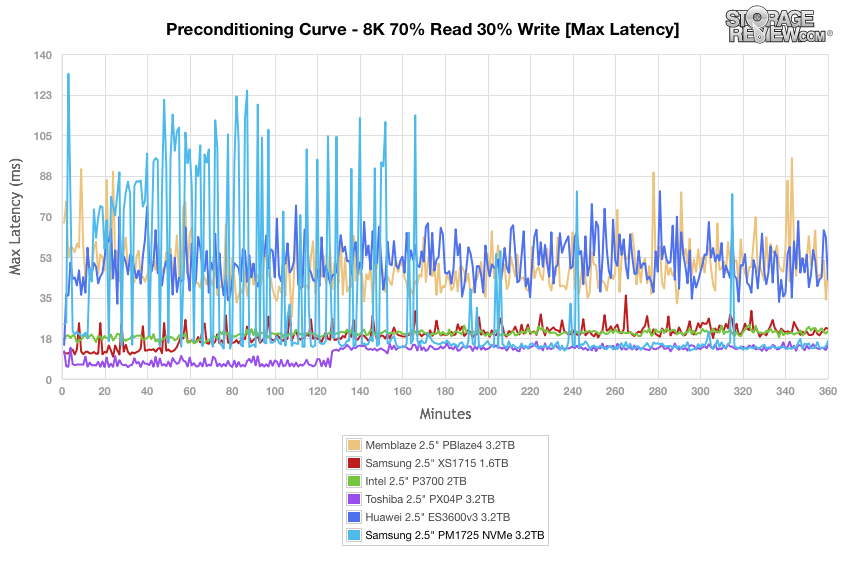
Standard deviation calculations for the 8K 70/30 preconditioning workload reflect that the maximum latency results we measured were not outliers. The PM1725 had the least consistent overall latency results among the comparables, with more pronounced spikes during the first three hours of the protocol.
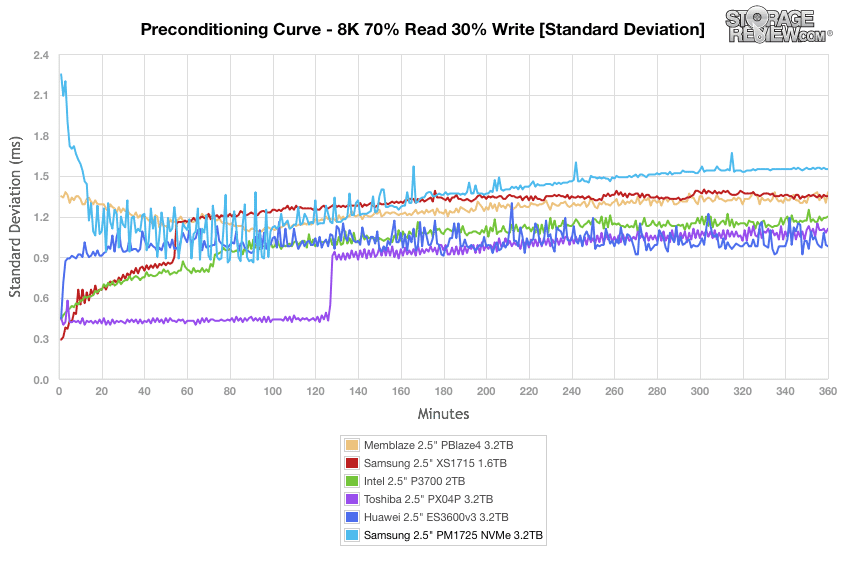
Once the preconditioning process was complete, we compared the Samsung PM1725’s 8K 70/30 performance against the comparables across a variety of workload intensities. In terms of throughput, the PM1725 consistently outperformed the Samsung XS1715 and the Memblaze PBlaze4, but otherwise remained at the middle of the pack.
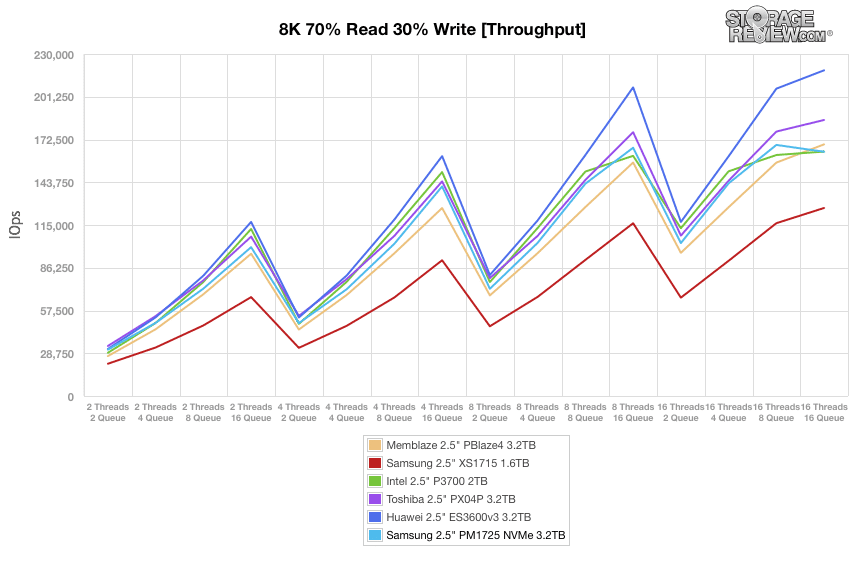
The average latencies we recorded for the PM1725 during the 8K 70/30 benchmark were typical for a drive in this class, but did not beat out any of the enterprise NVMe SSD frontrunners.
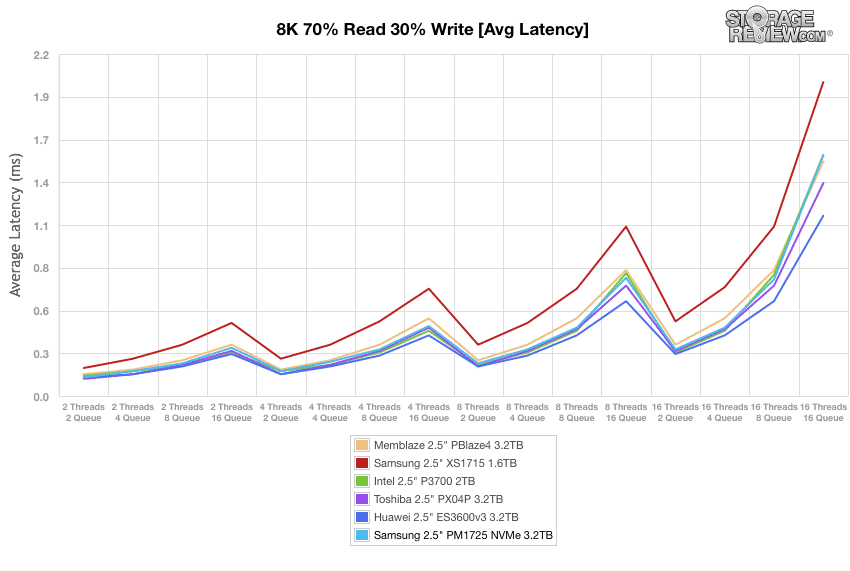
Unlike during its preconditioning for this benchmark, the PM1725 performed very well in terms of maximum latencies during the main 8K 70/30 test. The PM1725 and the Toshiba PX04P remained neck-and-neck across the variations in workload intensity, before both winding up near 16ms with the 16T/16Q workload.
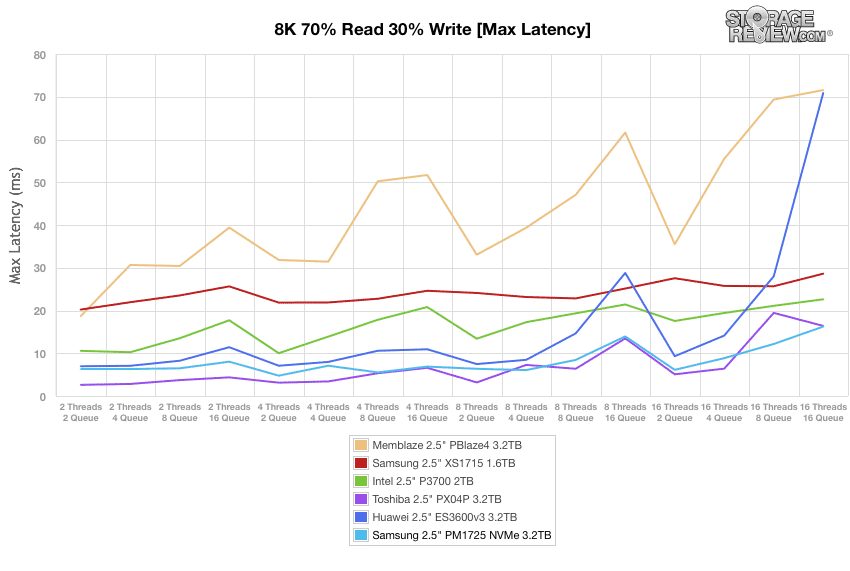
As we saw during preconditioning, the standard deviation results for our main 8K 70/30 benchmark show that the PM1725 did not achieve latencies more consistent than the comparables. Although unlike during preconditioning, the PM1725 generally did improve on the standard deviation results for the Samsung XS1715.
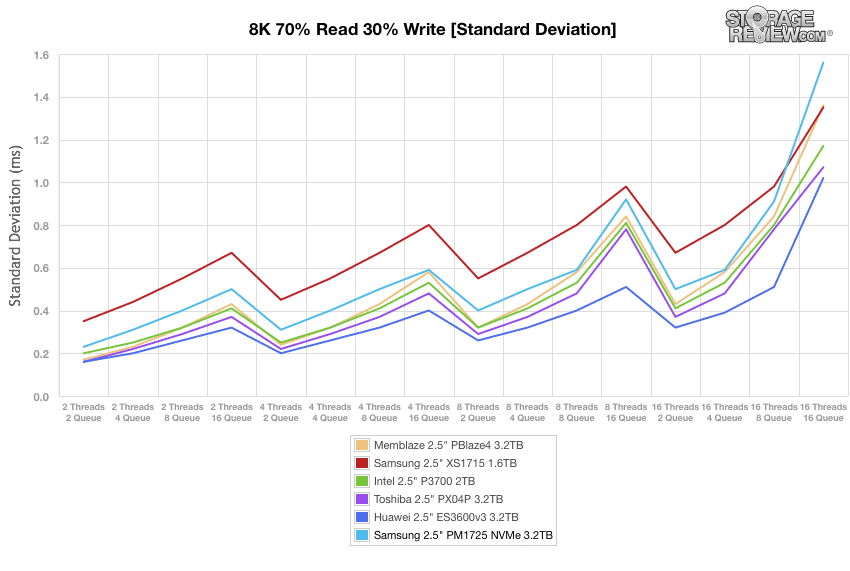
Conclusion
With recent successes like Samsung’s SATA-based PM863 as well as the SM863 (not to mention the prosumer Samsung 960 Pro M.2 NVMe SSD), we had great expectations for the company’s new enterprise NVMe offering. Samsung’s PM1725 is one of the newest members of a distinguished flash-storage legacy, although Samsung has not been actively promoting the PM1725 with the same enthusiasm as some of its other SSD releases, including the preceding XS1715.
When we put the PM1725 through the StorageReview Enterprise Test Lab’s benchmark protocol for enterprise SSDs, we found it to be a competently executed NVMe flash storage device, but not one that pushes the boundaries of the technology or the marketplace. The PM1725 improved on the XS1715 in virtually all regards, but this performance paled when compared against other enterprise NVMe SSDs that have been released during the same period. The trick with any SSD these days is the price/performance equation and buying enough drive, but not more than you need. Ultimately, the cost per IOP will likely determine the success of the PM1725 more than the upward limits of its capabilities.
Pros
- A high drive endurance rating backed by Samsung, a proven enterprise flash storage manufacturer
- Capacities up to 6.4TB in the HHHL form factor
Cons
- Performance falls behind other manufacturers’ current-generation enterprise NVMe SSDs
The Bottom Line
The Samsung PM1725 offers improved performance over its better-known XS1715 predecessor, but it falls behind the front runners in today’s enterprise NVMe SSD market.




 Amazon
Amazon